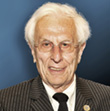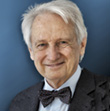Pioneers of electron microscopy receive the Kavli Prize
May 27, 2020 - The Norwegian Academy of Sciences awards the Kavli Prize for Nanosciences 2020 to Harald H. Rose (University Ulm and Darmstadt), Maximilian Haider (CEOS, Heidelberg), Knut W. Urban (Research Center Jülich) and Ondrej L. Krivanek (Nion, Kirkland) "for sub-Ångström resolution imaging and chemical analysis using electron beams“.
The development of aberration correction was initiated by the outstanding contributions of several scientists. Harald Rose has proposed novel lens designs that enable aberration correction in transmission electron microscopy that can be applied to both conventional and scanning microscopes. After more than 70 years of research, in 1998, Maximilian Haider finally succeeded in the technical implementation of this concept and the development of the first conventional aberration-corrected transmission electron microscope (TEM). In a research project together with Knut Urban, he realized the first sextupole corrector, based on Rose’s design, and implemented the first aberration corrected conventional transmission electron microscope. The Czech-American physicist Ondrej Krivanek (Nion Co.) realized the first aberration corrected STEM with sub-Ångström resolution well suited for spatially resolved chemical analysis using a quadrupole-octupole corrector.
"With these image-corrected lenses, it was not only possible to visualize individual atoms, but also their movements and interactions with unprecedented precision," explains Professor Harald Rose, senior professor at the University of Ulm.
Video 1. "Science in Focus" of the World Science Festival about the Kavli prize for Nanoscience 2020. Source: vimeo.com.
With their innovations, the four award winners laid the technological foundation stone for the extraordinary discoveries that have been made with transmission electron microscopes in the past decades. The fact that this remarkable development has not yet ended is shown by the development of the globally installed and newly developed aberration-corrected microscopes. More than 800 aberration-corrected electron microscopes are used today in research and more than 100 instruments in the semiconductor industry. Completely new atomic-scale TEM/STEM experiments are designed such as manipulating low-dimensional materials on the level of single atoms, observing and analyzing their movement. Physical breakthroughs are continuously achieved.
„Atomic resolution is vital for the investigation of low-dimensional materials such as nanotubes, graphene, and other thin materials from the strongly growing field of 2D materials nowadays. The aberration-correction has today also enabled atomic resolution at lower voltages, over a wide field of view in a single exposure.“, explains Professor Ute Kaiser, head of the group of Electron Microscopy for Materials Science at the University of Ulm. According to the increase in instrumentation and its advances, the number of journal publications based on aberration-corrected electron microscopy micrograph is increasing by 20% per year since 2008.
The four prize winners share a million dollar prize money. The prize is named after the physicist and entrepreneur Fred Kavli, a Norwegian by birth, who contributed his fortune to the Kavli Foundation after retiring from active business life. The Kavli Prize was awarded for the first time in 2008 and has been awarded every two years for the fields of astrophysics, nanosciences and neurosciences. The award ceremony will take place in Oslo, Norway on September 8, 2020.




